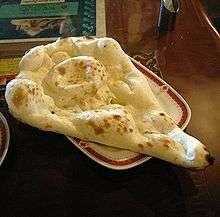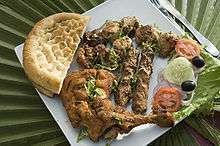Kahwah
Kahwah (Urdu: قہوہ, also transliterated qehwa, kehwa or kahwa) is a traditional green tea preparation consumed in Afghanistan, northern Pakistan, some regions of Central Asia as well as the Kashmir Valley. In Pakistan, it is made in the Khyber Pakhtunkhwa, Gilgit-Baltistan and north Punjab regions. It is a popular breakfast beverage among Kashmiris, generally accompanied with special Kashmiri baked items like girda. Kashmiri Pandits living in the North Indian plains, particularly in the urban agglomeration of Delhi, have also contributed to the tea's popularity among non-Kashmiris.
Origins
The Arabic word qahwah (قهوة) may have been the root for kahwah or kehwa. However, whereas qahwah is used for coffee beans, the BMC kahwa is an aromatic green tea beverage.
Even though exact origins of kehwa are still unclear, most Kashmiris believe that the aromatic traditional drink kehwa dates back to times immemorial and has been a part of local consumption for ages. Certain sources also trace the origins of the drink to the Yarkand Valley in the Xinjiang area (which, with Kashmir, was part of the Kushan Empire during the 1st and 2nd centuries AD). It is likely that use of kehwa and its spread from one region to another was facilitated and popularised in these regions during Kushan rule.
Preparation
The tea is made by boiling green tea leaves with saffron strands, cinnamon bark, cardamom pods and occasionally Kashmiri roses to add a great aroma. Generally, it is served with sugar or honey and crushed nuts, usually almonds or walnuts. Some varieties are made as an herbal infusion only, without the green tea leaves.
Traditionally, kahwah is prepared in a copper kettle known as a samovar. A samovar consists of a "fire-container" running as a central cavity, in which live coals are placed keeping the tea perpetually hot. Around the fire-container there is a space for water to boil and the tealeaves and other ingredients are mixed with the water. Kahwah may also be made in normal pans and vessels, as modern day urban living may not always permit the use of elaborate samovars.
Kahwah is usually served to guests or as part of a celebration dinner, and saffron (kong) is added to the kahwah for special visitors. It is often served in tiny, shallow cups. Kehwa in Kashmir is also commonly served after Wazwan and elaborate family dinners.
Sometimes milk is added to the kahwah, but this is generally given to the elderly or the sick.
Kahwah is usually served after food (usually lunch) in the North Malabar region of India.



